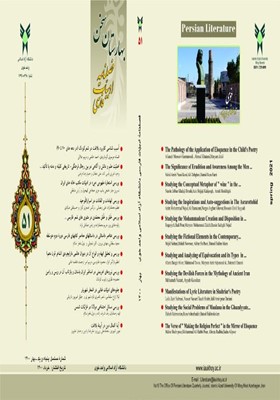Studying the Inspirations and Auto-suggestions in The Asrarottohid
Subject Areas : Abstract Articles
Azim Mohammad Nejad
1
,
Ali Ramazani
2
*
,
Narges Asghari Ghovar
3
![]()
1 - PhD student, Department of Persian Language and Literature, Ahar Branch, Islamic Azad University, Ahar, Iran.
2 - Department of Persian Language and Literature, Ahar Branch, Islamic Azad University, Ahar, Iran.
3 - Department of Persian Language and Literature, Ahar Branch, Islamic Azad University, Ahar, Iran.
Keywords: inspiration, corporeal, Divinity, Keywords: the Asrarottohid, auto-suggestion minds, angelic, satanic,
Abstract :
Abstract The Asrarottohid is a valuable literary and mystical book and the most important source in social history of Iran from 553 to 599 A. H. by Mahammad ibn Monawar Mihani in three chapters. All of the chapters of this book is about the biography of Sheikh Abu Saeed Abulkhayr. Since it is investigated for the first time, it deserves to be paid much attention. Besides the sensual memory, there are memories in the Asrarottohid and the method of receiving them were audio-visualism. Memories are of four types: divine , angelic , worldly and satanic. Divine is something that alights in the heart directly and leads the mind to general creation. Angelic comes to the mind indirectly and provokes man toward good deed and worship and keeps from mischief and sin. Corporeal comes to mind directly and hinders against sesualism and futile motives. Satanic come indirectly to the mind and leads the man to astray, depending on non-divinity element and not to ask God for help. Divine inspiration sometimes happen indirectly and the other times directly; those which occur indirectly need the instruments which enter the inspirations from the Almighty to man's heart. One of the mediators of inspiration are the angels. The opposite point of inspiration is auto-suggestion which happens through the satanic mind. The research method is descriptive-analytic one. The writers of this essay are to discuss samples of divine inspirations and satanic self-suggestions from the Asrarottohid.
فهرست منابع و مآخذ
الف: کتاب نامه
2- نهجالبلاغه، (1368)، ترجمة محمّد دشتی، تهران: بنیاد نهجالبلاغه.
3- ابن منظور، محمّد بن مکرم، (بیتا)، لسان العرب، بیروت، دار الصادر.
4- جوادی آملی، عبدالله، (1395)، تفسیر موضوعی قرآن، «معاد در قرآن»، جلد چهارم، تفسیر تسنیم، قم: اسراء.
5-. دهخدا، علیاکبر، (1346)، لغتنامه دهخدا، تهران: دانشگاه تهران، چاپ دوم.
6- رازی، فخرالدّین، (بیتا)، التفسیرالکبیر، مصر: مطبعه البهیه المصریه.
7- سجّادی، سیّدجعفر، (1383)، فرهنگ اصطلاحات و تعبیرات عرفانی، تهران: طهوری.
8- سعیدی، گل بابا، (1384)، فرهنگ اصطلاحات عرفان ابن عربی، تهران: شفیعی.
9- صافی گلپایگانی، لطف الله، (1394)، توضیح المسائل، قم: مهر، صص: 65-120.
10- طباطبایی، سیّد محمّدحسین، (1379)، المیزان فی تفسیر القرآن، تهران: دارالکتب الاسّلامیه.
11- طریحی، فخرالدّین، (1408 ق)، مجمع البحرین، قم: مکتب النشر الثقافه الاسلامیه، ص: 14-120.
12- فریدی خورشیدی، منا، (1390)، الهامات قدسی و القائات شیطانی از دیدگاه این ترکه و ملاصدرا، پایان نامه، تهران: دانشگاه علامه طباطبایی(ره).
13- کاشانی، عزالدّین محمود، (1387)، مصباح الهدایه ومفتاح الکفایه، به کوشش عفت کرباسی، تهران: زوّار.
14- مطهری، مرتضی، (1377)، معارف اسلامی در آثار استاد مطهری، قم: معاونت امور اساتید و دروس معارف اسلامی، چاپ سوّم.
15- معین، محمّد، (1375)، فرهنگ فارسی ، تهران: امیرکبیر، چاپ نهم.
16- میهنی، سعید، (1366)، اسرارالتّوحید، به کوشش محمّدرضا شفیعی کدکنی، تهران: آگه چاپ اوّل.
ب: مقالات
17- خسرو پناه، عبدالحسین و شایسته، حسین، (1393)، «بررسی نقش ابزاری موسیقی در کسب معرفت عرفانی از منظر عرفان اسلام»، مطالعات عرفانی، دورة 4، شمارة 20، صص: 115-142.
18- ربانی گلپایگانی، علی، (1391)، « مقاومت پیامبران در برابر القائات شیطانی»، نشریة کلام اسلامی، دورة 21، شمارة1، صص: 15-31.
19- سبحانی تبریزی، جعفر، (1386)، «نزول وحی به افراد عادی» مجلّة کلام اسلامی، دورة 4، شمارة 12، صص: 3-15.
19- صدرالمتألّهین شیرازی، محمّد بن ابراهیم، (1382)، الشواهد الربوبیه فی المنهاج السلوکیه، تصحیح و تعلیق: سیّد جلالالدّین آشتیانی، قم، بوستان کتاب، ص: 276-277.
20- طاهری، سیّد صدرالدّین؛ فریدی خورشیدی، منا، (1391)، «الهامات قدسی و القائات شیطانی از دیدگاه ملاصدرا»، دانشکده ادبیّات و زبانهای خارجی، نشریه پژوهشهای معرفت شناختی شمارة1، ص: 44-45.
_||_
